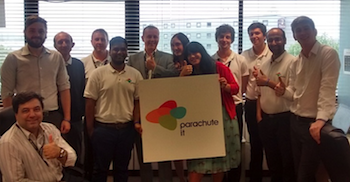Nimans has put together a range of special offers to support the recent launch of Panasonic's KX-NS700 SMB system.
These include preferential price support, free onsite sales training, a discounted training voucher and free sales support and marketing.
"The NS700 is a Smart Hybrid PBX suitable for small to medium sized offices," explained Paul Burn, Head of Category Sales at distributor Nimans. "We want to make it as easy as possible for resellers to embrace this innovative new system and take advantage of the many sales opportunities it creates.
"For example there is preferential price support for their first three deals and a demonstration kit. White label marketing support is also available.
"The NS700 is also designed to be used in call centre environments. Its built-in applications support the basic needs of supervisors, such as Queue Announcement, Live Status Monitor, Activity Report, Automatic Conversation Recording, and NAS (Network Attached Storage)."
Various activation keys are preinstalled or come with a 60-day free trial.
Burn added: "The KX-NS700 has a built-in messaging system that provides voice mail to subscribers. The Unified Messaging system can also provide voice guidance to outside callers, either directing them to their desired destination or to the mailbox of a subscriber, where they can leave a voice message."

 The UK partner channel developed by Pragma, the distributor set up by channel legend David George just two years ago, has grown by 26% in the last 12 months.
The UK partner channel developed by Pragma, the distributor set up by channel legend David George just two years ago, has grown by 26% in the last 12 months. The London leg of the nationwide Comms Charity Go-Karting challenge led by Chess in support of the Prince's Trust and Sparks culminated with Chess Chief Exec David Pollock being named Champion, beating Simon Tompkins of Jaguar Telecoms into second place while Chess Partner Services' Joe Green completed the podium.
The London leg of the nationwide Comms Charity Go-Karting challenge led by Chess in support of the Prince's Trust and Sparks culminated with Chess Chief Exec David Pollock being named Champion, beating Simon Tompkins of Jaguar Telecoms into second place while Chess Partner Services' Joe Green completed the podium. eBillz MD Arvind Meghani enthused: "We had such a fantastic time. The event was well planned, well run and the race was good fun. Most significantly, we have raised some money for some great charities."
eBillz MD Arvind Meghani enthused: "We had such a fantastic time. The event was well planned, well run and the race was good fun. Most significantly, we have raised some money for some great charities." Daisy Wholesale has added telecoms data analytics to its Hosted Voice Exchange (HVX) solution following a link-up with Tollring.
Daisy Wholesale has added telecoms data analytics to its Hosted Voice Exchange (HVX) solution following a link-up with Tollring. Chess has acquired IT systems provider Parachute IT adding £2.2 million to its turnover and 17 additional staff to the Group. Parachute IT will be known as Chess ICT and joins earlier acquisitions ebillz and Chess Partner Services at one of the company's satellite offices in Borehamwood, Hertforshire.
Chess has acquired IT systems provider Parachute IT adding £2.2 million to its turnover and 17 additional staff to the Group. Parachute IT will be known as Chess ICT and joins earlier acquisitions ebillz and Chess Partner Services at one of the company's satellite offices in Borehamwood, Hertforshire.